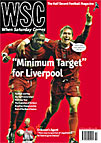 Ian Plenderleith finds artists from Norway and Switzerland exploring the meaning and limits of the game (and the language), while Englishmen past and present have captured the game’s historic vistas
Ian Plenderleith finds artists from Norway and Switzerland exploring the meaning and limits of the game (and the language), while Englishmen past and present have captured the game’s historic vistas
The history of football and art is littered with badly proportioned pencil drawings, misty-edged portraits and, on the pitch, mostly miscued overhead kicks that end up leaving their artists flat on the canvas. Once in a while, though, those overhead shots hit the target and we celebrate the beauty, just as the occasional non-playing artist captures something of the game’s elusive but undeniable aesthetic side.
It’s all a matter of taste, of course, and I’m certainly no qualified critic, but the digital art project Art Onside produced by Steinar Rosenberg to commemorate the centenary of the Fredrikstad club in Norway seems to capture a certain grace, colour and movement in their figures that made me think: “I want full-size posters of those. Now. Or at least a set of postage stamps.” Especially with titles such as Gul Spiller and Svart Keeper.
Rosenberg describes the pictures as “my humble contribution” to the joint venture between the club and the local arts centre, whose aim was to centre on “the idea… that at the core of both football and art is the joy of life”. Fans of Carlisle United and Darlington, or even casual observers of Norway’s national side, may want to dispute that appraisal, but the results illustrate the potentially positive outcome of such inventive collaborations.
British artist Mackenzie Thorpe concentrates less on the players and more on the fans in the works that make up his 56-picture The Game Of Life collection, which toured the UK last year. Most of Thorpe’s figures are either kicking a ball about in the grey backstreets of his native Middlesbrough or climbing on their dad’s shoulders to get a better view. His car-free, smokestack landscapes are an evocative throwback to pre-Riverside times, although titles such as The Boy Who Didn’t Get A Ticket and Mrs, Can We Have Our Ball Back? (below) are unnecessarily literal unless you’re describing the picture rather than looking at it.
Thorpe now lives in California, making up some sunlight deficiencies for all those years he spent under the unsoaped skies of the north-east, but I doubt he’s ready just yet to paint a dazzling and cheerful portrait of the LA Galaxy’s Home Depot Stadium. His allure comes from brushing dollops of colour into dull backgrounds, a perhaps more accurate reflection of football’s true character than the Fredrikstad “joy of life” theory.
“In football as in art everybody is convinced that they are experts and that they know what is good [and] what is not.” These are the words of Swiss artist Stefan Banz , but that’s about as much sense as he makes in explaining his six-minute video Hitzfeld, which depicts his 1997 art installation inspired by going to watch his son play football and being confronted with the questions (as you often are): “What is the relationship between art and football? What happens if, for instance, works generally known in art become concepts and appear on the football ground, replacing the advertising?”
To answer this crucial poser, Banz sponsored the young team’s shirts by having printed on each one the name of an artist and one of their famous works. So “Bank At Goldvaults!” was replaced by, for example, “Edouard Manet Le Déjeuner sur L’Herbe”. The result? According to his website, “Banz found that… the names and titles remain strange, mysterious, uncomfortable words to the uninformed at the edge of the field – but even then do they change perception and produce a world of ambiguous imagination and association. Furthermore, the continuous action of the players on the field constantly produces new constellations of names and titles and therefore an exhibition in continuous change. The football field becomes a mobile ‘musée imaginaire’ – a continually changing, de-materialised object of pure imagination in real, living, moving bodies.”
The reactions of the other parents, or the “uninformed” Swiss man walking his dog, are sadly not recorded, but Banz’s explanation of how Ottmar Hitzfeld “stands for all the emotions connected with art and football” is definitely worth a read, especially if you are a Southampton-based artist intending to mount your own installation – say, a mobile imaginary museum entitled Strachan.
Still, as any old-timer on the terrace of either the ground or the gallery will tell you, in football as in art it’s all been done before. In 1954 the Football Association sponsored a competition on the subject of Football and Art, and the winner was LS Lowry’s Going To The Match. Currently on exhibition at The Lowry in Salford to celebrate its 50th anniversary, the painting is Jack Charlton’s favourite because: “This is just like it was in those days when I was young: all wooden open stands, cinders underfoot, terrible conditions in the toilets.”
And there wasn’t a surveillance camera, or video installation, in sight.
From WSC 204 February 2004. What was happening this month